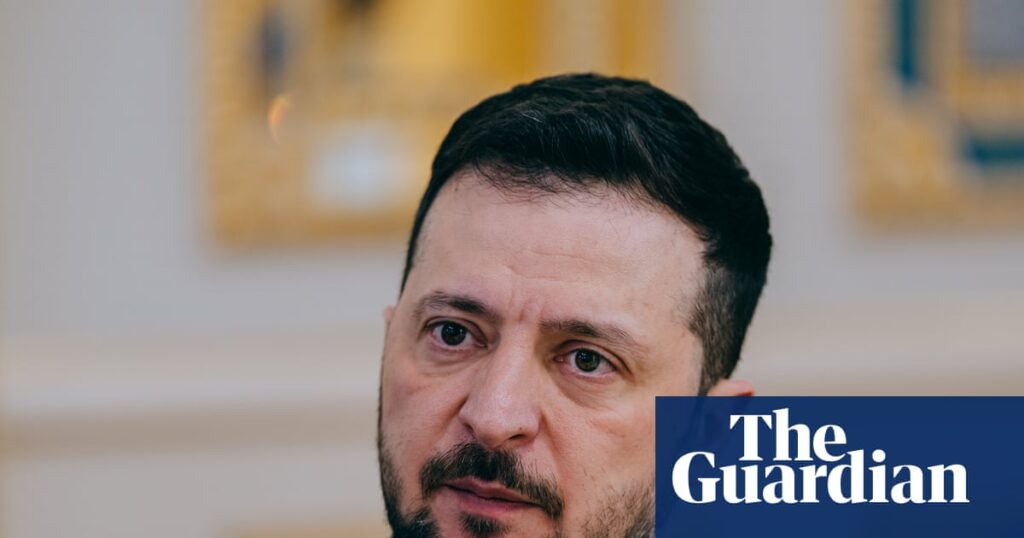Ukraine’s president has said he will fly to Washington on Monday to meet Donald Trump after an hour long call with the US president in which he was briefed on the key points of the Alaska summit with Vladimir Putin.
Next week’s meeting will mark the first return to the White House for Volodymyr Zelenskyy since his infamous row with Trump and the vice-president, JD Vance, in the Oval Office in February.
“President Trump informed [me] about his meeting with the Russian leader and the main points of their discussion,” Zelenskyy wrote, adding that Ukraine supported Trump’s proposal for a trilateral meeting between the three leaders.
Zelenskyy did not spell out the key points of discussion between Trump and Putin. Later, the president’s chief communications adviser said they “haven’t heard anything” about a possible air ceasefire before a trilateral summit, a proposal posted on social media by a journalist.
Trump told Fox News after the summit that the swapping of territory in Ukraine was discussed with Putin – something Zelenskyy has repeatedly ruled out.
“I think those are points that we negotiated, and those are points that we largely have agreed on,” the US president said. “I think we’re pretty close to a deal,” he added : “Ukraine has to agree to it. Maybe they’ll say no.”
After their call, Trump said on Truth Social that he expected to see Zelenskyy on Monday afternoon, and that “if all works out we then will schedule a meeting with president Putin” though the Russian leader has previously been reluctant to meet his Ukrainian counterpart.
The US president also said “the best way to end the horrific war” would be “to go directly to a Peace Agreement, which would end the war, and not a mere Ceasefire Agreement, which often times do not hold up”. With Russia and Ukraine far apart in their demands, it is not clear how easily that could be achieved.
European leaders joined the call for a further half an hour, Zelenskyy added, emphasising that “it is important that Europeans are involved at every stage to ensure reliable security guarantees together with America”.
Those joining the call included the leaders of the UK, France, Germany and Italy: Keir Starmer, Emmanuel Macron, Friedrich Merz and Giorgia Meloni respectively;
as well as the Polish and Finnish presidents, Karol Nawrocki and Alexander Stubb; the Nato secretary general, Mark Rutte, and the president of the European Commission, Ursula von der Leyen.
Shortly after, a second phone call took place, this time between Zelenskyy and various European leaders, to discuss what they had learned from Trump’s account of the summit.
There were “positive signals” from the US, Zelenskyy said in his update, “regarding participation in guaranteeing Ukraine’s security”, echoing diplomatic language from last week in the runup to the summit.
Previously, the US has declined to spell out how it might help prevent a future outbreak of fighting as part of a peace agreement, leading to speculation that Washington was looking to leave the safeguarding of Ukraine almost entirely to Europe.
A joint statement from the leaders of the UK, France, Germany, Italy, Poland, Finland and the EU thanked Trump for his mediation efforts, and said they hoped to work towards “a trilateral summit with European support”.
The group said Ukraine “must have ironclad security guarantees” and welcomed Trump’s statement that “the US is prepared to give security guarantees”. Reuters reported that there was a discussion of extending a Nato-style guarantee to Ukraine, though the US position on this was not clear.
The leaders also declared “it will be up to Ukraine to make decisions on its territory” and that “international borders must not be changed by force”. The group said they would be willing to implement further economic sanctions against Russia if necessary.
In a separate statement, Starmer said that while progress had been made, “the next step must be further talks involving president Zelenskyy” and he emphasised that “the path to peace in Ukraine cannot be decided without him”.
Meloni said “the most interesting developments” at the summit were regarding future security guarantees for Ukraine. She highlighted an earlier Italian proposal “inspired by Nato’s article 5”, a clause that states alliance members will come to each other’s aid if one is attacked.
“The starting point of the proposal is the definition of a collective security clause that would allow Ukraine to benefit from the support of all its partners, including the USA, ready to take action in case it is attacked again,” she said.
Pressure on Russia had to be maintained, Macron said in a social media post. “Any lasting peace must be accompanied by unwavering security guarantees,” he added, welcoming “the readiness of the United States to contribute”.
Meanwhile, fighting continued for the 1,270th day since Russia launched its full-scale invasion in February 2022. Three people were killed and 12 wounded in the southern frontline region of Kherson, its governor reported on Saturday.
Ukraine’s Azov brigade said it cleared Russian saboteur groups from six villages as it began to close down a breach in the frontline near Dobropillia, in the eastern Donetsk province. The unit claimed it had killed 271 Russian soldiers and wounded 101.
Ukraine’s air force said one ballistic missile and 85 drones and decoys were launched into the country, and it had shot down 61 of the latter. Russia said it had taken two villages on the frontline and Ukraine said it had lost another village near Pokrovsk.

